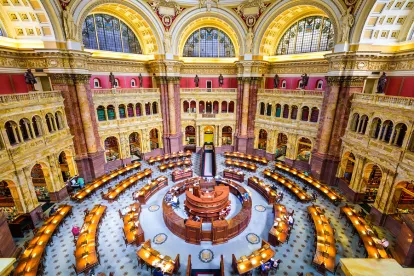The Beltway Buzz is a weekly update summarizing labor and employment news from inside the Beltway and clarifying how what’s happening in Washington, D.C., could impact your business.
Congress on Spring Break … What’s on Deck? The U.S. Congress remains out on spring break this week and is scheduled to return to Washington, D.C., the week beginning April 8, 2024. With 2024 funding for the federal government wrapped up, upon its return, Congress will turn its attention to the myriad items that have stacked up on its to-do list. This includes authorizing funds to rebuild Baltimore’s Francis Scott Key Bridge and provide military aid to Ukraine. Additionally, Congress will likely consider a business-supported tax bill, social media legislation, the reauthorization of a post–9/11 provision of the Foreign Intelligence Surveillance Act, and the reauthorization of the Federal Aviation Administration, among other matters. At the Buzz, we will be particularly interested in Congressional Review Act resolutions addressing the National Labor Relations Board’s joint-employer rule and the U.S. Department of Labor’s independent contractor rule.
Federal Contractor News. The latest employment-related news from the federal contracting world includes the following:
- Federal contractor portal opens. On April 1, 2024, the Office of Federal Contract Compliance Programs (OFCCP) opened its Contractor Portal “where covered federal contractors and subcontractors must certify, on an annual basis, whether they are meeting their requirement to develop and maintain annual [affirmative action programs].” Covered contractors have until July 1, 2024, to register and certify their compliance. Instructions, frequently asked questions (FAQs), and how-to videos are provided by OFCCP.
- New veteran hiring benchmark. OFCCP has announced that, effective March 31, 2024, the national hiring benchmark for protected veterans is 5.2 percent. As Christopher J. Near points out, the benchmark has declined every year since its adoption in 2014.
Immigration News. The confluence of two recent U.S. Citizenship and Immigration Services (USCIS) final regulations—the H-1B modernization rule and the new fee schedule—contributed to a busy week as far as immigration policy goes:
- H-1B cap met. After extending the fiscal year (FY) 2025 H-1B registration period, USCIS has announced that it “has received enough electronic registrations for unique beneficiaries” to meet the FY 2025 cap for H-1B visas. According to the announcement, pursuant to a random selection process, USCIS has “notified all prospective petitioners with selected beneficiaries that they are eligible to file an H-1B cap-subject petition for such beneficiaries.” USCIS began accepting petitions on April 1, 2024.
- New fee schedule in effect. USCIS was quick to remind filers that their petitions are subject to the new fee schedule that USCIS adopted on January 31, 2024. This new rule schedule went into effect on April 1, 2024, after a federal judge denied a legal challenge to enjoin the rule. According to USCIS, “Petitions postmarked on or after April 1, 2024, must include the new fees or [USCIS] will not accept them.”
- Work authorization extended. On April 4, 2024, USCIS announced the issuance of a temporary final rule to “increase the automatic extension period for certain employment authorization documents (EADs) from up to 180 days to up to 540 days.” According to the news release, the rule “will prevent already work-authorized noncitizens from having their employment authorization and documentation lapse while waiting for USCIS to adjudicate their pending EAD renewal applications and better ensure continuity of operations for U.S. employers.” The rule applies to “(1) applicants who timely and properly filed their Form I-765 applications on or after Oct. 27, 2023, if the application is still pending on April 8, 2024; and (2) applicants who timely and properly file their Form I-765 application on or after April 8, 2024 and on or before Sept. 30, 2025.”
MSHA Silica Rule on the Way. Late last week, the Office of Information and Regulatory Affairs completed its review of the Mine Safety and Health Administration’s (MSHA) final silica rule. This means that a final rule is likely to be published in the Federal Register at any moment. William K. Doran and Margaret S. Lopez have the details on the changes proposed by MSHA.
Justice William O. Douglas. On April 4, 1939, the U.S. Senate confirmed William O. Douglas as a member of the Supreme Court of the United States. A Columbia Law School–trained attorney, Douglas spent time as a law professor at Yale before President Franklin Delano Roosevelt appointed him to the U.S. Securities and Exchange Commission. In 1939, when Justice Louis D. Brandeis retired from the Supreme Court, FDR nominated Douglas to be Brandeis’s replacement. On the Court, Douglas developed a reputation as a civil libertarian (he wrote the majority opinion in Griswold v. Connecticut, 381 U.S. 479 (1965), relating to privacy and the use of contraceptives), and he advanced novel legal theories, including an expansive view of standing. Dissenting in a1972 decision, Douglas wrote, “Contemporary public concern for protecting nature’s ecological equilibrium should lead to the conferral of standing upon environmental objects to sue for their own preservation.” During his time on the Court, Douglas was the subject of two failed impeachment attempts, one in 1953 for his vote to stay the executions of Julius and Ethel Rosenberg, who were convicted of spying for the Soviet Union, and again in 1970, allegedly for his judicial opinions, as well as his controversial “side hustle” writings and activities. Aside from his jurisprudence, Douglas holds several Supreme Court records that still stand today. He served longer—thirty-six years, from 1939 to 1975—than any other Supreme Court justice. He also had more marriages (four) and more divorces (three) than any other justice. Douglas also wrote more than thirty books, which some claim were necessary to pay for the divorces and settlements.




 />i
/>i

